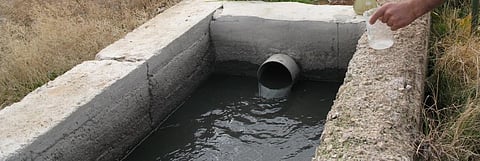

Textile units at Bhituja Industrial Area in Rajasthan’s Barmer district continues to pollute groundwater and the adjoining Luni river, noted a report by a joint committee formed by the National Green Tribunal (NGT) made public April 12, 2021.
The area’s common effluent treatment plant (CETP) was unfit to treat the effluents from the bleaching units, the committee found. It was unable to comply with the prescribed discharge standards notified by the Union Ministry of Environment, Forests and Climate Change (MoEF&CC) in 2016.
As many as 191 textile units were connected with the CETP.
The joint comprised members from MoEF&CC, Central Pollution Control Board (CPCB) and Rajasthan State Pollution Control Board (RSPCB). RSPCB collected samples from five randomly selected units February 18, 2021 and the committee’s observation was based on the analysis of these samples.
The textile units are engaged in desizing (chemical removal of sizing material from fabric), mercerising (a finishing treatment to enhance lustre and dye affinity) and bleaching processes. Caustic soda and sodium hypochloride are used in mercerising and bleaching, respectively.
What did RSPCB find?
After treatment, the biological oxygen demand (BOD) of the effluents was nearly eight times higher than the prescribed BOD of 30 milligram per litre (mg / l).
The chemical oxygen demand (COD) was over five times the prescribed standard of 250 mg / l.
Further, there is no treatment available to reduce the total dissolved solids (TDS) to the prescribed norms.
The pre-effluent treatment (settling tanks) provided by each unit was unable to control the total suspended solids (TSS). The sludge from the tanks was pumped out and flown into the CETP, increasing the latter’s TSS load. It resulted in solid deposition in the plant’s waste stabilisation ponds.
Solar evaporation ponds (SEP) are used for storing wastewater but all the three SEPs at the site were found filled to their capacity and the stagnant effluent was seeping into Luni river to the south of the plant.
Partially treated effluent was also found to be illegally pumped out to nearby land, the committee found.
CETP was not recycling the treated effluents from the bleaching units, increasing the hydraulic load on SEPs.
Why was the committee formed?
The joint committee was set up following an NGT order dated December 7, 2020 to probe the capacity of the CETP. It was asked to take a final decision by March 2021. CPCB was appointed the nodal agency for coordination and compliance.
Along with samples from the textile units, RSPCB also analysed groundwater from tubewells, inlet and outlet of the bleaching units and and inlet and outlet of the CETP.
Action taken
The waste treatment facility at Bhituja was being improved to handle the load from the textile industry, the committee observed.
“The upgrade would help in settling the suspended solids effectively at the clariflocculator unit. The sludge thickener and centrifuge machines will help in managing the settled sludge effectively,” said a CETP official.
There should not be any relaxation in the prescribed standards for total/fixed dissolved solids to prevent further damage to Luni, the committee recommended.
NGT had also ordered rejuvenation of Luni by controlling hazardous industrial and sewage sludge discharge.